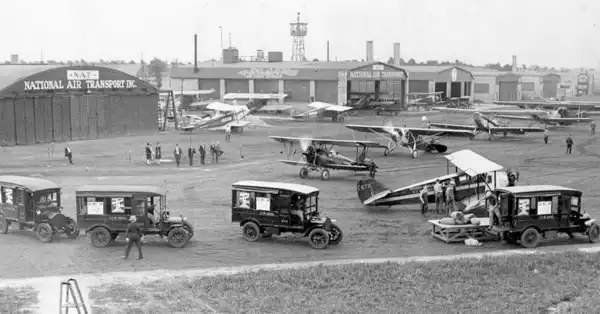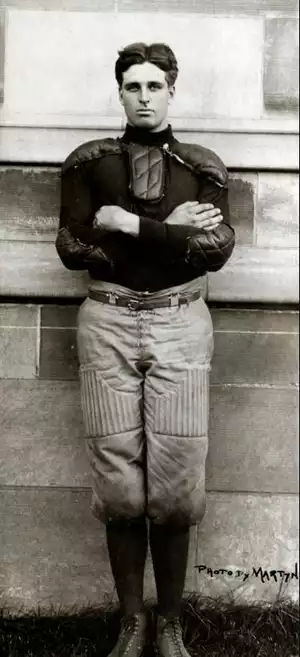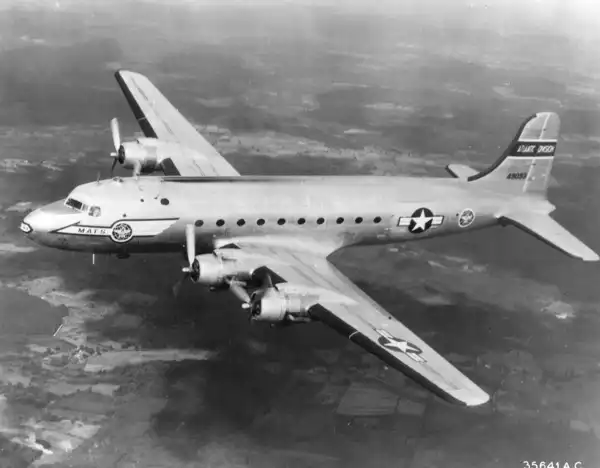Orchard Place/Douglas Field: Its Early History
The establishment of O'Hare Field, Chicago International Airport as a major transportation center had its beginnings in the 1930's when the City of Chicago began looking for an airfield to supplement Municipal Airport, (now known as Midway) that was the city's principal aviation facility.

Soon after Municipal Airport's opening on May 8, 1926, aviation enthusiasts and local journalists, recognizing that the airport was too small to accommodate Chicago's anticipated traffic growth began to call for the acquisition of more land and the construction of new buildings. Chicago Alderman John J. Coughlin of the 1st Ward declared in a Tribune article dated January 1, 1929, "Chicago is destined to become the air center of the United States, and adequate facilities should be provided without delay." This call for more land and new facilities was quickly endorsed by local leaders, including Mayor Anton Cermak who in November 1931 presided over the dedication of a $450,000 expansion.
However, even this effort proved to be inadequate, as the rapidly evolving aviation industry continued to develop larger and faster commercial passenger airliners. These new aircraft required longer runways, and more sophisticated hanger facilities so in 1934 the Chicago Belt Line Railroad bordering the northern edge of Municipal Airport was relocated and Municipal Airport was expanded once again. The work was done by the Works Progress Administration (WPA) and the Civil Works Administration (CWA) through a $10 million federal grant which took Municipal to its present size of about one square mile. At the time, many aviation experts considered Municipal's size sufficient for modern aircraft and stated in an American Society of Planning Officials article that the Airport was adequate to handle the "safe operation of the largest aircraft in operation now or proposed for the immediate future."
While the "experts" in the American Society of Planning Officials were convinced that Municipal's runways and aircraft facilities were of sufficient size and sophistication to accommodate forecasted traffic volumes, others in the Chicago metropolitan area were not so sure. Beginning in the mid-1930's and continuing on through that decade, local officials with an interest in aviation searched the suburbs west of the City for a suitable site for a second airport; and while a number of sites were discussed, nothing really developed from these discussions until just before the outbreak of World War II.
Until the war, the federal government's response to submissions from Illinois for new airfields or defense plants was always the same as exemplified by this response by Major General George H. Brett of the Army Air Corps to a request by Illinois Senator C. Wayland Brooks. Senator Brooks, who had a keen interest in aviation had sent the General some geological survey maps from the Chicago Association of Commerce and asked the General to consider an Illinois site for an air base. General Brett replying in a letter dated November 6, 1941 stated that the "Air Corps does not contemplate the establishment . . . (of an air field in Illinois). . . at the present time."
Just a month later the entire picture changed when the Empire of Japan bombed Pearl Harbor, Hawaii and the United States entered World War II.
Within a few days of the Pearl Harbor attack, locating sites for airfields and new defense plants in the Midwest moved to the top of the priority list as government planners quickly recognized the advantages of placing defense production activities in the center of the country far from the vulnerabilities of either coast.

The actual job of selecting these sites fell to the Office of Production Management: Aircraft Section and the chief of that section, Merrill C. Meigs, was the former publisher of the Chicago Herald-Examiner and Chairman of the Chicago Aero Commission. Mr. Meigs formed a site selection committee for the production of large aircraft and it was to this committee that Chicago area leaders made their presentations. Key among the presenters was E. Paul Querl, Director of Industrial and Aviation Development for the Chicago Association of Commerce and an individual very familiar with the numerous sites available for airfield and defense plant development in the Chicago area.
Querl's favored a site near the small farming community of Orchard Place which had been settled by German immigrants and New England pioneers in the 1840's and developed into a railroad stop in 1887. This location had been one of a number of possible sites identified during the searches of the 1930's and because of its proximity to the city, availability of a highly skilled labor force and easy access to major modes of transportation, especially rail, was in Querl's opinion the best choice for a new aircraft manufacturing facility.

In the end, Querl prevailed, but not before the Army Air Corps and the aircraft manufacturer had their say. The Douglas Aircraft Company of Long Beach, California had a plant under construction in Oklahoma City in early 1942 for manufacturing its largest airplane, the four-engined C-54 "Skymaster". The company also had orders for the smaller two-engined C-47 "Dakota," which was also in great demand. In order to meet these competing demands and respond to the desires of federal planners for a Midwest production facility, Douglas agreed to shift C-47 production to Oklahoma City and build a new plant in the Chicago area for the C-54.
On April 22, 1941, "Special Orders" were issued in the name of Major General H. H. Arnold to send three men from Washington D.C. to Chicago as a "Board of Officers" and a site selection committee to inspect and approve a site for the Douglas plant. The three officers, Major Marlboro K. Downes, Major Albert J. Wehrell and Second Lieutenant Harold B. Neely, convened the Board in Chicago on April 23 1942 and began their site evaluation.
In all, nine sites were visited by the selection committee; a Ford site at Lansing, Illinois; Rubinkam Airport at Harvey; Orchard Place near Bensenville; St. Charles Airport; Aurora Airport; Joliet Airport; a site near Elgin; and two sites near Municipal Airport. The sites at St. Charles, Aurora, Joliet, and Elgin lacked utilities and railroad facilities and the two Southside sites were too close to Municipal Airport to insure a safe operation, so the Chief of Engineers in Washington D.C. informed the Chicago Office of the Army Corps of Engineers to chose one of the three remaining sites: Ford at Lansing; Rubinkam near Harvey; or Orchard Place.
These three locations were then thoroughly studied by the Corps. They made estimates of construction time and costs, studied wind speed and direction, noted possible obstructions to clear zones for aircraft operations, evaluated soil quality, and structure and determined the adequacy of drainage. In the final Board Report submitted to the selection board, the engineers concluded that the Rubinkam site had poor drainage and very limited potential for expansion; the Ford site lacked adequate housing for workers and the transportation infrastructure to support a major manufacturing facility. While Orchard Place was not perfect it did meet all the basic requirements for manufacturing large aircraft.
Before the Board Report was submitted to the War Production Board for approval, a meeting was held in the office of Robert Kingery at the Chicago Regional Planning Association, where representatives from the Army Corps of Engineers (including their civilian consultant Ray W. Hazekamp), the Chicago Association of Commerce, Douglas Aircraft Company and the Chicago Regional Planning Association discussed the merits and drawbacks of each site and formulated their final recommendations. The evaluators also discussed their conclusions with a full colonel in Washington D.C. who further questioned them on technical and political aspects of the report before it was submitted.
In an interview with Ray W. Hazekamp conducted on January 6, 1970, he expressed the opinion that much of this analysis and discussion took place "because Representative Adolph J. Sabath (from the Lansing area) had to be satisfied that the best site was being recommended." Hazekamp, who had worked for the Civil Aeronautics Administration in the 1930's "would have favored a field further west with more open space rather than just examining sites presented by the Chicago Regional Planning Association." But there was a war going on, and the country needed defense plants quickly, so the ad hoc discussion group agreed to "table" their differences and submit their recommendations to the Board.
The Board Report was submitted to the War Production Board a few days after these discussions and the Board approved the Orchard Place site in June 1942. Soon after the announcement of Orchard Place as the site of the new Douglas plant a local newspaper carried the following headlines: "$20 million war plant for Bensenville area" and "Army to buy 1300 acres for Douglas Aircraft and airport".
From this point forward, events move quickly despite strenuous objections from many local groups who wanted the area to maintain its rural and residential character. Public hearings were scheduled in Park Ridge City Hall on June 18, 1942, to rezone Orchard Place from agricultural land to industrial use. Following this meeting, Judge William J. Campbell signed an order to condemn the property for government use, and the Army Air Corps began to acquire land for development.
During this same period, the Austin Company was hired as the prime contractor, and field preparations began. By July 1942, the area was being cleared of fences and buildings, and architecture and engineering (A&E) work was underway through the efforts of people from Austin, Douglas, and the Corps of Engineers.
After the land was cleared the first development activity was to grade the site and install drain lines. As with other concrete infrastructure activities, the lines were unreinforced to save steel. Next, an underground heating tunnel was built from the site of the future powerhouse to encircle the area and connect the buildings. The first building was begun on June 30, 1942 and the main factory building was begun on August 24. In November 1942 the first section of the factory was turned over to Douglas for operation. The personnel and administration buildings, plus the cafeteria, were finished shortly thereafter.

The main factory building covered about forty-three acres. The critical shortage of steel made it necessary to use wood and non-strategic materials as much as possible. Since the plant was needed only during the war, materials with short "operational lives" were not considered a problem and while the plant had higher than normal operating costs it performed up to expectations.
The Douglas plant was named U.S. Air Force Plant 8 by the government.
When it was completed, the Assembly Building (known as T6) totaled more than two million square feet of production and administrative space. It was thought to be the largest all-timber manufacturing plant in the world. Trusses and columns were constructed on the site from one-inch boards of varying lengths, and the shop that did the fabrication handled more than 31,750,000 board feet of lumber. Uncertainties about the quality of the wood provided for the construction motivated engineers to overdesign the building, thus ensuring its structural integrity and adding to its weight and cost.
Not only was this site one of the largest aircraft manufacturing facilities in the country but it was also a major airport. Of particular interest was the critical placement of the four runways which would determine the operational characteristics of the airfield. The main runway which ran in a northwest-southeast direction was designed and its placement directed by the Chicago area Civil Aeronautics Administration Office which wanted it to parallel Municipal Airport's main traffic pattern for safety and operational reasons during instrument flight conditions.
The runways, like the utility tunnels and drainage systems, were also built under wartime restrictions. Lacking reinforcing rods, the contractor made the runways thicker than was customary for airports at that time to save steel. There were four runways of 5,500 feet each; all were 150 feet wide and had a base of stone 15 inches thick covered by a seven to ten-inch layer of concrete. The last paving was completed on August 1, 1943. However, take-offs and landing didn't began until the spring of 1943.
Ten months into construction, the main factory was ready for operation. The project also included an administration building, boiler house, garage, cafeteria, health center, paint shop, and hangers, plus an airfield, a paved surface area of 1,300,000 square feet, and a parking area for 6,300 automobiles. The work was completed ahead of schedule and met all contractual requirements, including the strict use of non-critical materials. The cost of the project was $40.5 million.
On July 30, 1943, the first C-54 "Skymaster" rolled down the Chicago Aircraft Assembly Plant runway and into the sky with test pilot Win Sargent at the controls. The aircraft had rolled off the assembly line a little over a year after land-clearing work had begun. Full production continued until the end of the War with virtually no disruption to the production schedule until the plant closed in October 1945.
On July 18, 1944, less than a year after the first C-54 rolled off the assembly line, a fire completely destroyed the Administration Building. Firemen from nine suburban departments fought the blaze, which was visible for miles, but damage beyond the Administration Building was minimal because the designers had taken great care to make sure that there was sufficient space between buildings to prevent the spread of fire. In early August, the cornerstone for a new Administration Building was laid, and by October, workers were moving back into the new facility.
Newspapers of the day reported the cause of the fire was undetermined.
As stated above, the plant ceased production in October 1945 when contracts with the army and navy ended. During its brief life, the Chicago Aircraft Assembly Plant at Douglas Field produced 655 large cargo planes for the Armed Forces supplying vitally needed air transports to both the European and Pacific theaters.
There was talk of building airliners at the old assembly plant, but nothing came of it as aircraft manufacturing re-consolidated on the West Coast and the Chicago area returned to more traditional production activities. However, although Boeing manufactured its commercial aircraft on the West Coast, it moved its corporate office to Chicago in 2001. In 2022, it moved them again to Arlington, Virginia.
SPECIAL NOTE and ACKNOWLEDGEMENT: Much of the material for this brief description of the history of Orchard Place/Douglas Field before it became O'Hare Field, Chicago International Airport has been extracted from Richard P. Doherty's Doctoral Dissertation entitled The Origin and Development of Chicago-O'Hare International Airport written at Ball State University Muncie, Indiana in August, 1970.